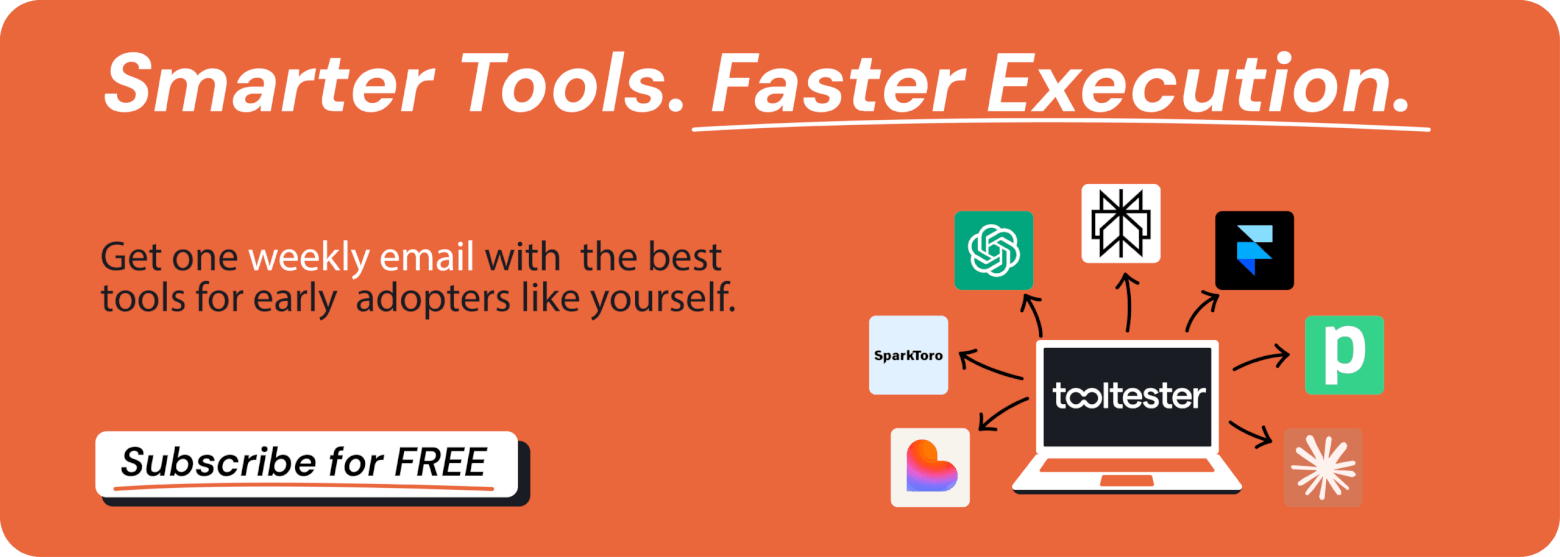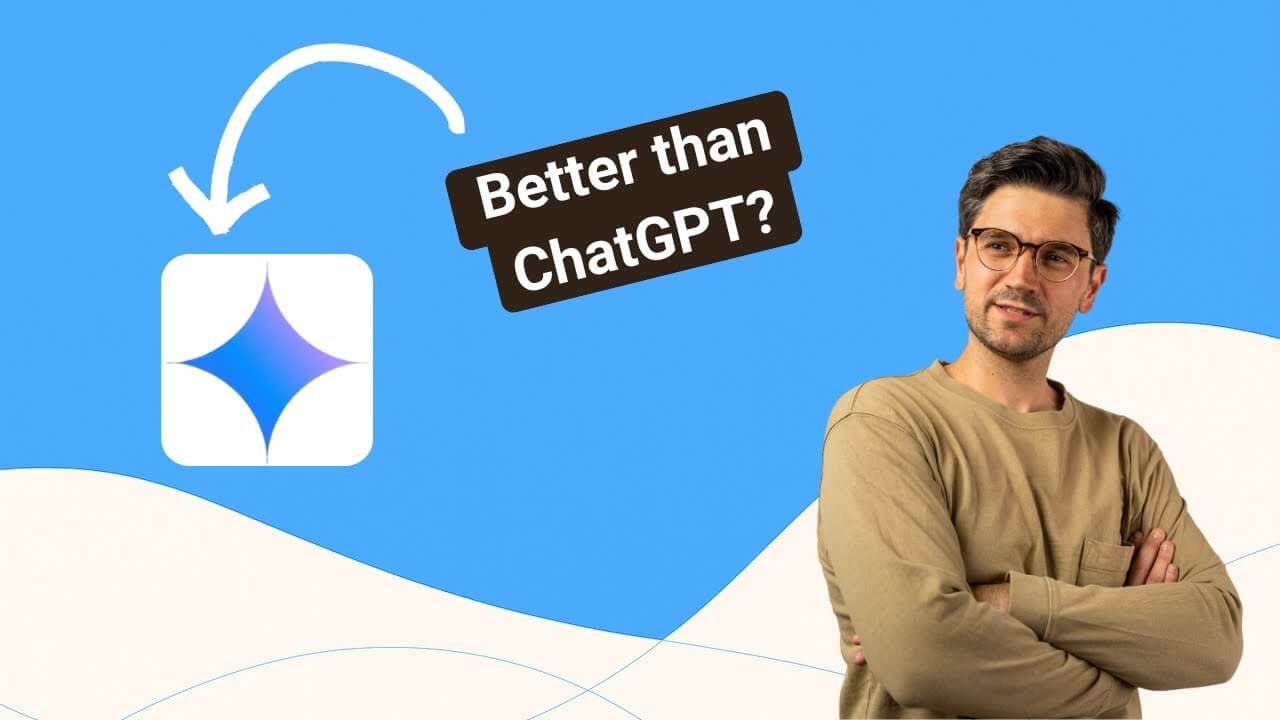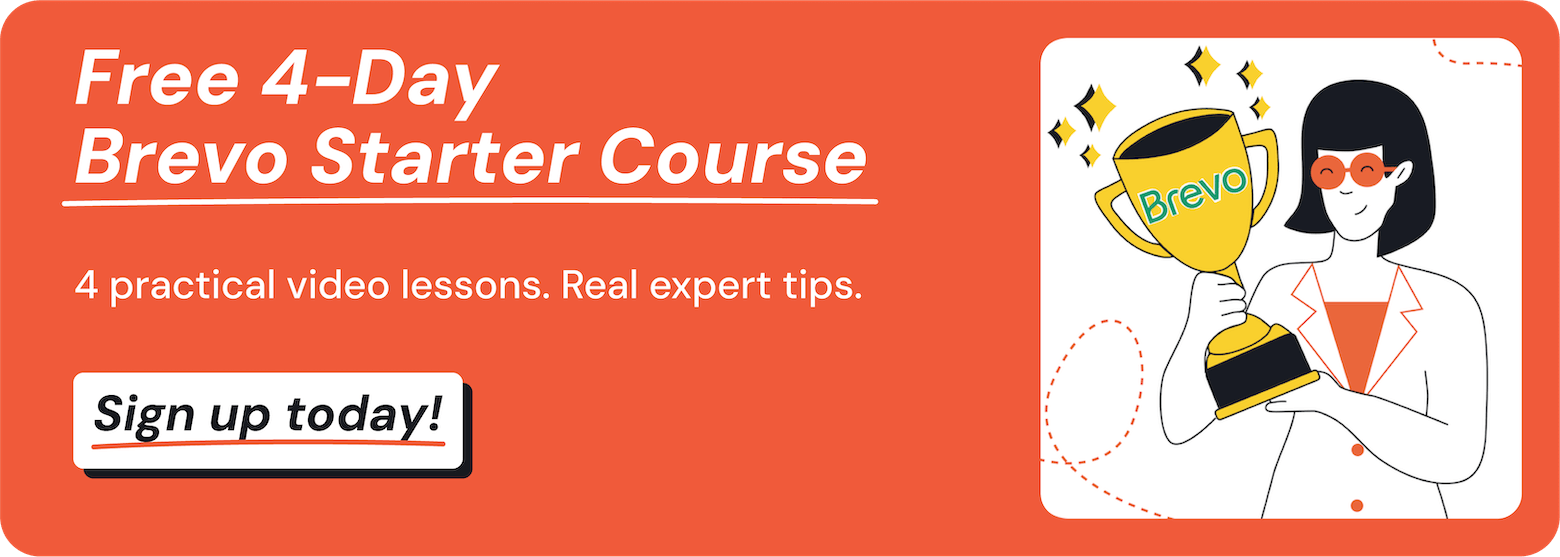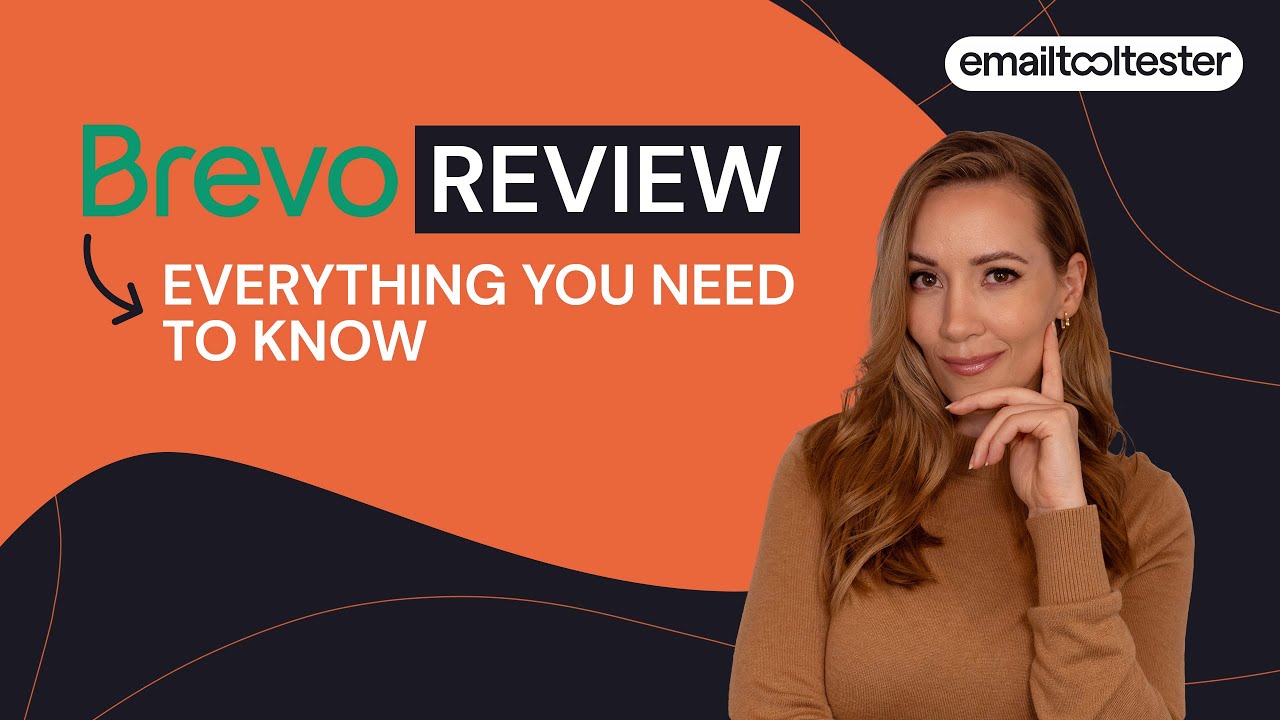EmailTooltester is supported by readers like yourself. We may earn a commission when you purchase through our links. Of course, this won't increase the cost for you.
If there’s one thing we marketers know how to do, it’s get creative – especially when it comes to getting the most out of a free marketing tool.
It’s funny, because back when I worked at marketing agencies, “free” often meant “barely usable”. But today, things couldn’t be more different. At EmailTooltester, our team spends our days testing marketing tools, from all-in-one platforms to niche apps. And incredibly, we’ve found that many free marketing tools actually rival (or even outperform!) their paid counterparts.
As we’ve discovered, the key to finding good free tools – ones that punch above their weight and help you do more with less – is to know where to look.
That’s why I’ve asked the team here at EmailTooltester to share the free tools they actually use day to day. I’ve grouped these handpicked favorites by stage of the marketing journey, from getting discovered to building loyalty, so that you’ll know exactly which ones to try, and when.
Whether you’re running a small business, growing a newsletter, or just trying to make your marketing budget go further, I hope this list helps you find a few new favorites that make your work easier, smarter, and maybe even a little more fun.
20 Best Free Marketing Tools: Our Roundup

Stage 1: Awareness
- Canva – For eye-catching graphics
- Google Gemini – For writing your blogs, emails and captions
- Unsplash – For high-quality stock images
- Semrush – For finding relevant keywords
- SparkToro – For getting closer to your audience
- Buffer – For managing your social media
Stage 2: Engagement
- Brevo – For email marketing (and more!)
- Kit – For sending and monetizing newsletters
- Hubspot – For building conversion-optimized landing pages
- Involve.me – For building quizzes and funnels
Stage 3: Conversion
- Dealfront – For turning website visitors into leads
- SimplyBook.me – For client meetings and bookings
- Microsoft Clarity – For understanding user behavior
Stage 4: Retention
- Typeform – For collecting customer feedback
- Systeme.io – For growing a community
- Smile.io – For rewarding loyal customers
- Google Reviews – For building trust and social proof
Stage 5: Growth
- Zapier – For automating your marketing stack
- Claude – For AI-driven marketing automation
- Notion – For organizing marketing workflows
Stage 1: Awareness — Getting Discovered
You can have the best product in the world, but what good is it if no one knows you exist? Every great marketing journey starts with one simple goal: getting noticed.
That’s where these free tools come in. Regardless of whether you’re looking to design scroll-stopping visuals, find the right keywords to target, or plan your social content, they’ll help you attract the right kind of attention (without spending a cent!).
1. Canva: For eye-catching graphics
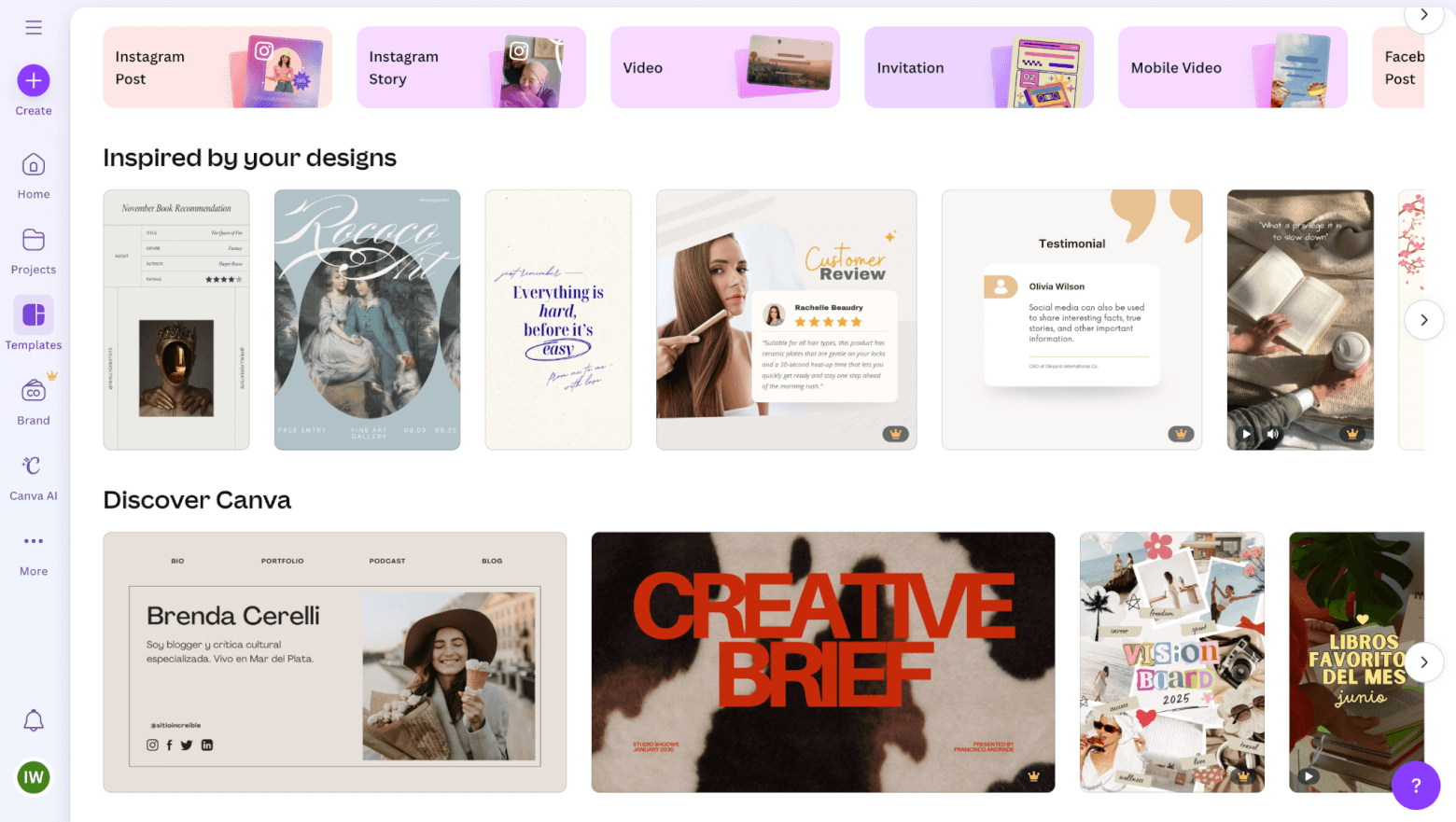
For quick social media graphics, charts, and AI-generated illustrations, Canva is our team’s go-to tool.
You don’t need any design skills to get started, which is honestly the magic of Canva. Even on the free plan, you get access to millions(!) of templates, a rich library of free photos, icons, design elements, and a drag-and-drop editor that makes visual creation fast and accessible.
Just type a prompt and Canva’s AI helps you not only get started on your design, but also tweak it to get the ideal result (although bear in mind that AI features are restricted on the free plan). We’ve used it to create everything from data-driven charts and blog banners, to short promo videos and slide decks.
See what my colleague Josep had to say about using Canva’s AI tools:
Pros (free plan):
- Generous access to thousands of templates, fonts, and free design assets
- Easy to use, making it great for beginners
- AI tools (Magic Write, Magic Media) available, albeit with strict usage limits
Cons (free plan):
- No transparent background or SVG export
- Search results include premium (Pro) assets that you can’t filter out
- Only one brand kit allowed; no advanced brand control features
- No video generation features on free plan
- Storage is limited — free users get 5 GB of cloud storage
Pricing: Canva is free to use with the above features. If you upgrade to Canva Pro (starting at $12.99/month), you unlock premium templates, full AI usage (higher limits), background removal, brand kits, export to SVG/transparent formats, and more.
2. Google Gemini: For writing your blogs, emails and captions

If you need a strong LLM for marketing copy, reports, or social content, you’ve probably thought of using ChatGPT. But for small businesses, Gemini is worth a look (especially if you’re already in the Google ecosystem).
On the free plan, Gemini works much like a chatbot: ask it to write a post, outline a report, or generate ideas. One standout feature is Deep Research (with limited access), which helps speed up content creation by surfacing relevant facts, summaries, or context.
You also get access to other content generation tools, such as Flow (Google’s AI-powered filmmaking tool), and their image generation/editing tools (Whisk, Nano Banana, and Google AI Studio).
Gemini also benefits from a large context window, which means it can process more content in one go without losing track of your earlier prompts. On the free plan, this is capped at 32,000 tokens, which is equivalent to around 50 pages of text.
Here’s what Josep found when he tested it:
Pros (free / baseline):
- Free access tied to any Google account; no extra payment needed
- Generous context capacity (32,000 tokens) for handling longer content
- 100 monthly AI credits for using with Google’s video and image generation tools
- Deep Research (limited uses) to help with idea generation
- Basic integration with Google tools (Gems, prompt memory)
- 15GB of storage across Google Photos, Drive and Gmail
Cons (free / baseline):
- Free users are capped at 5 prompts per day (for the 2.5 Pro model)
- Advanced features like video generation (Veo 3) and enhancements inside Docs, Sheets, and Slides require paid plans
- No “Projects” system (as seen in Claude or ChatGPT’s organization features)
- Uploads of spreadsheets/data analysis and some file types are restricted to paid users
Pricing:
Gemini is free to use, with access to Gemini 2.5 Pro (limited use) and the features mentioned above. To unlock features like Veo 3, larger usage limits, or more advanced integrations, you’ll need a Google AI Pro plan, which starts at $19.99/month. Gemini is also included in Google Workspace plans.
3. Unsplash: For high-quality stock images

When you need quick, professional-looking images without worrying about licenses, Unsplash is hard to beat. Its library of over 6 million free, high-resolution photos covers almost every topic imaginable, from startup offices to coffee cups to dreamy landscapes.
You can download and use photos for commercial and personal projects with no attribution required. That makes it an excellent resource for blog images, social posts, and email visuals. Our team uses it all the time for both professional and personal projects.
The free plan is completely open: there’s no account requirement to browse or download. If you do sign up, you can save favorite images, follow photographers, and build collections. Unsplash+ (the paid upgrade) adds access to exclusive premium images, higher download limits, and priority support.
Pros (free plan):
- Completely free to browse and download; no sign-up required
- Generous license for commercial and personal use
- Huge variety of high-quality photos and styles
- Includes photos and illustrations
Cons (free plan):
- Some images feel overused or generic
- Search results often include premium Unsplash+ images (and these are usually the best ones!); however you can filter them to only include “Free”
4. Semrush: For finding relevant keywords

Once you’ve got your visuals and content sorted, it’s time to make sure people can actually find them. That’s where SEO tools come in.
When it comes to keyword research, Semrush is one of the most powerful all-in-one SEO platforms around – and the good news is that you don’t need a paid subscription to get started.
The free plan gives you access to several of its keyword tools. You can analyze up to 10 reports per day and see 10 keyword results per query, which is often enough to test ideas or find content opportunities. For example, you can quickly check a keyword’s search volume, competition level, and trend data, or peek at a competitor’s top-ranking keywords.
We often use Semrush’s free plan when researching smaller content projects because it’s fast, accurate, and gives a realistic sense of what’s worth targeting before diving deeper.
Pros (free plan):
- Accurate keyword data with volume, competition, and trends
- Generous access to core keyword tools (10 daily reports)
- Includes domain and competitor overview data
- Trusted, industry-standard SEO platform
Cons (free plan):
- Limited keyword results and daily searches on the free plan
- Need to upgrade to access unlimited searches, full keyword lists, historical data, and deeper competitor analysis (and there’s a big jump in price from free to paid plan!)
- Interface can feel overwhelming due to the number of available tools
- Requires sign-up (and occasional re-authentication) to keep using free tools
Pricing: Semrush offers a free plan with access to Keyword Overview, Keyword Magic Tool, and Domain Overview (limited to 10 queries/day). But be warned – paid plans start at around $165/month, so it’s quite a big jump from the free tier to a paid plan.
5. SparkToro: For getting closer to your audience
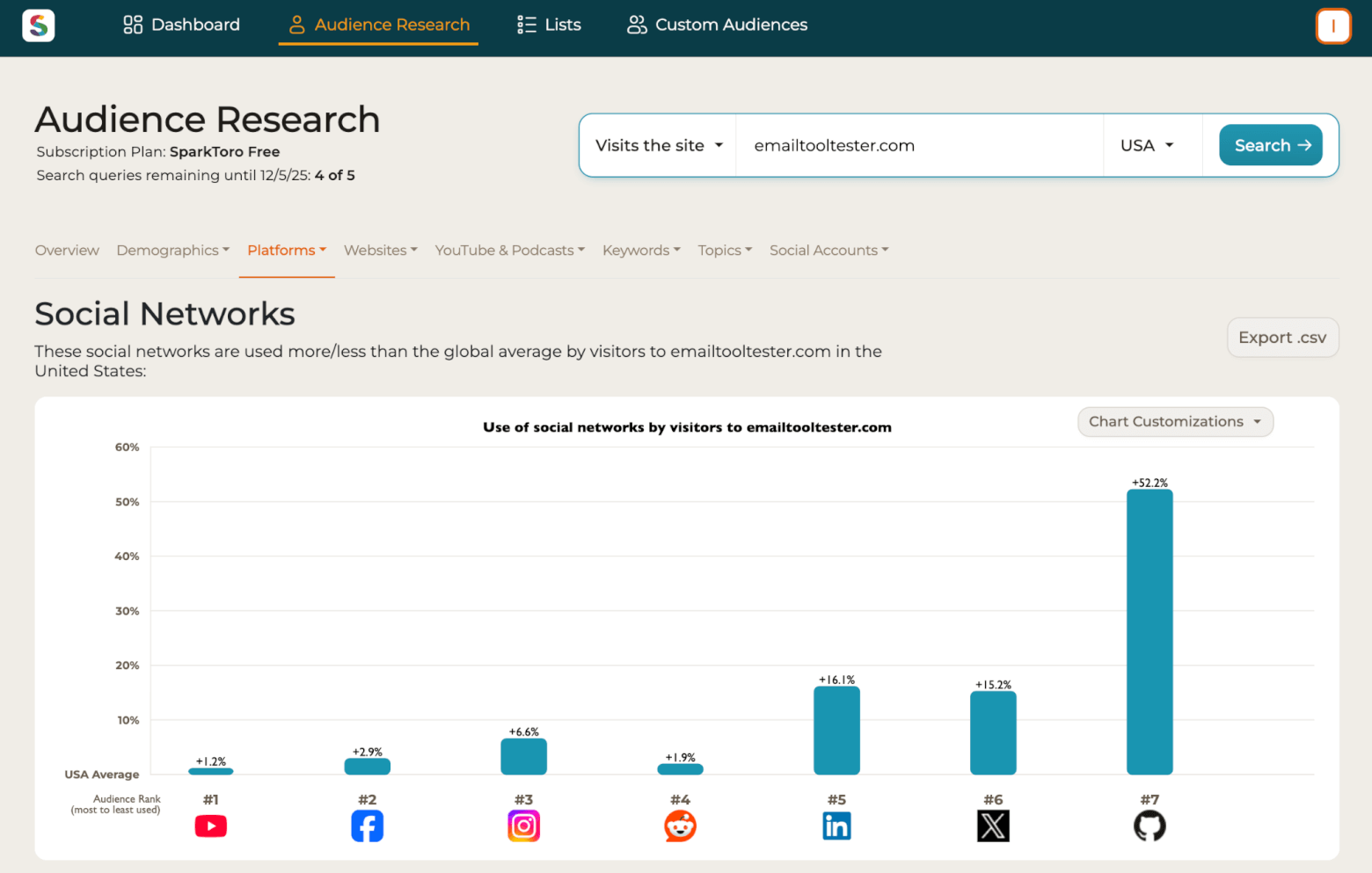
Customers rarely make a purchase after seeing your brand once. It usually takes multiple touchpoints across different channels, which is why knowing where your audience spends time and what they pay attention to can make all the difference.
That’s where SparkToro shines. It helps you discover where your customers (or competitors’ audiences) hang out online, from the social accounts they follow and websites they visit, to the podcasts they listen to and keywords they use.
These insights are invaluable when you’re planning content or deciding where to invest your marketing energy. We’ve found SparkToro particularly useful for brainstorming outreach campaigns and identifying smaller, niche platforms that traditional analytics often overlook.
The free plan gives you up to 5 searches per month, which include a snapshot of audience sources, social accounts, and frequently used phrases. You can also see limited data on websites and podcasts your audience engages with.
Pros:
- Uncovers audience data that traditional SEO or analytics tools don’t
- Great for refining content and influencer marketing strategies
- Intuitive dashboard and exportable data
- Free plan offers real value for small campaigns or niche targeting
Cons:
- Limited to 5 searches/month on the free plan and sampling of results only. Need to upgrade to unlock more searches, detailed demographics, and full data exports.
- Paid plans are relatively expensive for casual users
- Data coverage strongest for English-speaking markets
Pricing: SparkToro’s free plan allows 5 searches per month with limited audience data. Paid plans start at $38/month for 50 searches and include full demographic and audience insights.
6. Buffer: For managing your social media
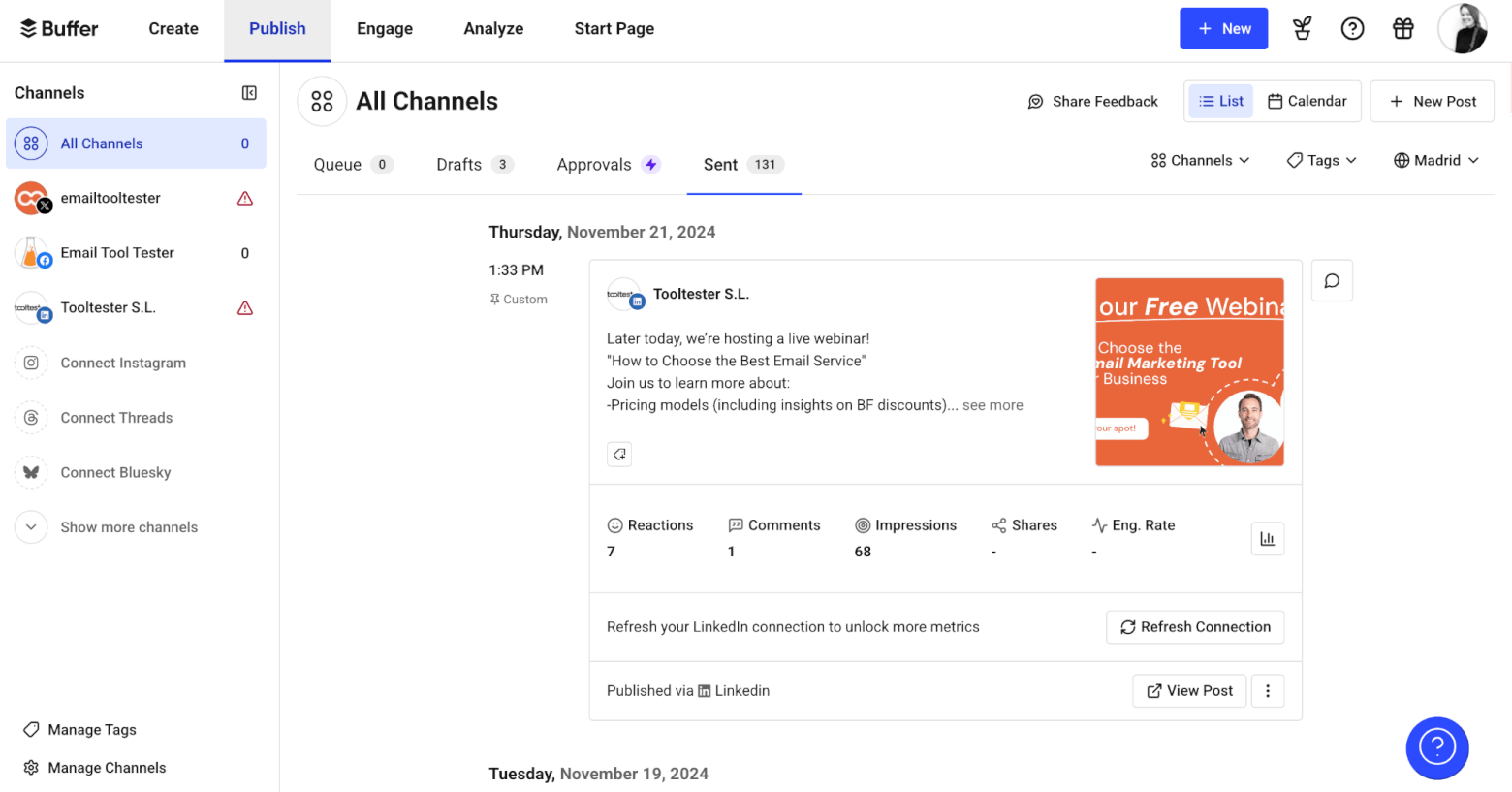
If your target market spends a lot of time on social media, consistency is key. But as you’ll know, managing multiple accounts can quickly become overwhelming. Buffer makes it easy to plan, create, and schedule posts across platforms from one simple dashboard.
The free plan is perfect for small businesses or solo creators just getting started. It includes up to 3 social channels (for example, Instagram, LinkedIn, and X) and allows you to schedule up to 10 posts per channel.
We’re big fans of Buffer’s AI Assistant, which helps you write posts faster by suggesting captions, hashtags, and repurposing ideas. Even on the free plan, you can try this feature to speed up content creation. The visual calendar view also makes it easy to drag, drop, and reorganize posts, which is a huge time-saver when your schedule changes.
Pros (free plan):
- Intuitive, easy-to-use interface
- Excellent scheduling and calendar tools
- Helpful AI Assistant for generating post ideas and captions
Cons (free plan):
- Not ideal if you have more than 3 accounts
- Advanced analytics, engagement tools, and team collaboration require paid plans
Pricing: Buffer’s free plan includes 3 social channels and 10 scheduled posts per channel. Paid plans start at $5 per month per channel, unlocking advanced analytics, engagement features, and more AI-powered tools.
Stage 2: Engagement — Building Relationships
Once people start noticing you, the next challenge is keeping their attention. Engagement is where relationships begin, and the focus here is on turning casual visitors into subscribers, leads, and loyal followers.
At this stage, your marketing tools should help you stay connected, collect contact info, and start meaningful conversations. And some of the best ones for doing exactly that are completely free.
7. Brevo: For email marketing (and more!)

We’ve tested dozens of email marketing platforms over the years at EmailTooltester — and Brevo (formerly Sendinblue) is one of the few we actually use ourselves. Why? Because it does so much more than email.
Even on the free plan, Brevo gives you access to a surprising range of tools: email marketing, SMS campaigns, signup forms, automation workflows, live chat widget, and even a CRM for managing deals and pipelines. You can send up to 300 emails per day, design newsletters with a drag-and-drop editor, and manage unlimited contacts — something most other free plans restrict. You can even use Brevo's AI-powered copywriter for free.
We also love that Brevo’s free plan includes transactional emails (for things like order confirmations and password resets). For small businesses, freelancers, or creators just getting started, it’s one of the most generous all-in-one marketing suites around.
And good news – if you want to learn how to get the most out of Brevo, we’ve created a free Brevo Starter Course that walks you through setup, authentication, automations, and analytics. In short: everything you need to start sending confidently. Get started below:
To learn more about Brevo, watch our Brevo video review:
Pros:
- Generous free plan with email, automation, CRM and live chat widget
- Unlimited contacts, with no hidden list caps
- Includes transactional emails
- Excellent upgrade path as your business grows
Cons:
- Brevo branding on free-plan emails
- Send limit of 300 emails/day can be restrictive for larger campaigns
- Landing pages, advanced automation and A/B testing features require higher-tier plans
Pricing: Brevo’s free plan includes 300 daily email sends, unlimited contacts, and access to key tools like automations, forms, CRM, and transactional emails. Paid plans start at around $9/month, removing Brevo branding and raising sending limits.
8. Kit: For sending and monetizing newsletters

Kit (formerly ConvertKit) has become one of the go-to email platforms for creators and bloggers, especially those looking to build and monetize newsletters. Its standout feature is the ability to sell digital products, memberships, and paid subscriptions directly from your account.
We actually use Kit to send our weekly Tooltester Newsletter, and can vouch for how well it serves creators wanting an easy, reliable way to grow and monetize their audience.
What makes Kit particularly impressive is its generous free plan, which supports up to 10,000 subscribers – far more than most competitors offer. Free users can send unlimited emails, build unlimited forms, and even use Kit’s creator monetization tools to start earning from their content right away.
The free plan also includes one automation and one email sequence, which is enough to build a simple welcome flow or drip campaign. We also like Kit’s support and simplicity, and that you can create landing pages without needing a website, making it ideal for social-first creators who want to grow directly from Instagram, YouTube, or TikTok.
See Kit in action in our video review:
Pros:
- Exceptionally generous free plan (up to 10,000 subscribers)
- Monetization features for digital products and paid newsletters included in free tier
- Excellent tagging system for audience segmentation
- Fast, friendly customer support
Cons:
- Free plan includes Kit branding and recommended newsletters
- Only one automation and sequence allowed on free tier
- Visual email design options are limited, and landing page editor is not the most flexible
- Must contact Support to activate the free plan after trial
Pricing: The free Newsletter plan includes up to 10,000 subscribers, unlimited emails, and monetization features. Creator plans start at $39/month for up to 1,000 subscribers, unlocking unlimited automations, paid recommendations, and integrations.
9. HubSpot: For building conversion-optimized landing pages

Although it’s known primarily as a CRM platform, HubSpot’s CMS Hub also includes a free landing page builder that lets you create up to 30 pages.
The builder itself is intuitive and flexible, with a drag-and-drop editor and a great selection of modern templates from the Theme Marketplace. You can create pages for sign-ups, lead magnets, or meeting bookings in just a few minutes. Each template is optimized for conversion, and HubSpot even provides built-in recommendations to help you improve things like mobile friendliness and SEO settings.
Because the landing page tool is connected to HubSpot’s CRM, every lead you capture is automatically stored in your contact database. You can then nurture these leads using HubSpot’s free email marketing tools, which include customizable templates, contact segmentation, and basic performance analytics.
We also like that you can add blog feeds, pricing cards, and dozens of other content blocks to make your landing pages more dynamic.
Learn more about Hubspot’s landing page builder in our video:
Pros:
- 30 free landing pages included
- Built-in CRM and email marketing tools
- Great template selection optimized for conversions
- Helpful SEO and mobile optimization tips
- Supports multilingual pages
Cons:
- No custom domain on the free plan
- HubSpot branding appears on all pages
- Automations and AI features locked behind paid plans
- No Google Analytics integration on the free tier
Pricing: HubSpot’s free plan includes 30 landing pages, CRM, and email marketing tools. Paid plans start at around $20/month for access to custom domains, advanced automation, and AI features.
10. Involve.me: For building quizzes and funnels
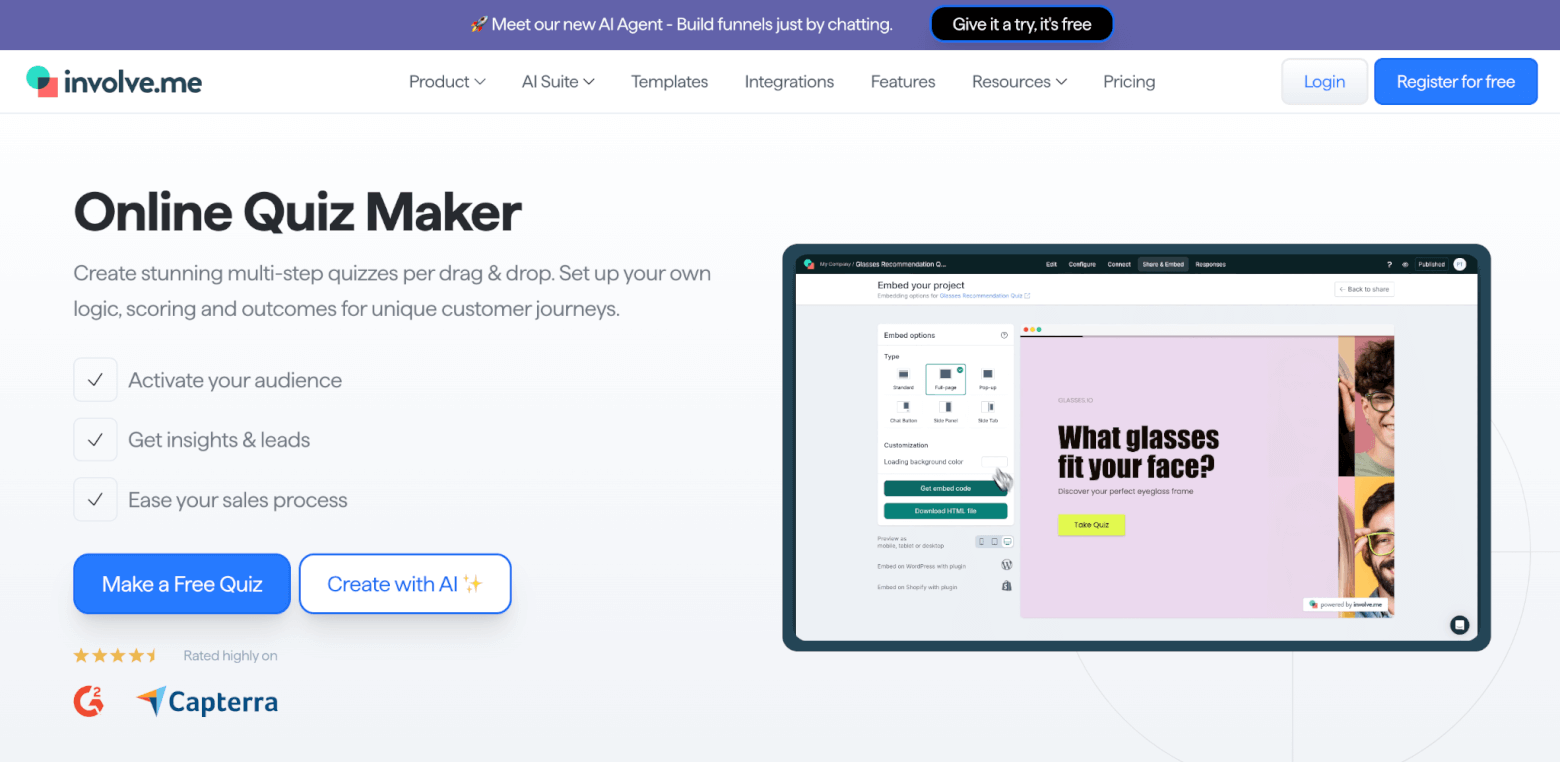
Looking to turn casual visitors into engaged leads? Involve.me is one of the most user-friendly tools for doing just that. It lets you build interactive quizzes, surveys, calculators, and lead funnels to boost engagement and personalize the customer journey.
The drag-and-drop builder is fast, flexible, and surprisingly easy to navigate. You can add scoring, conditional outcomes, and embedded calendars without touching any code.
The free plan lets you publish up to two quizzes or funnels and collect 50 responses per month, which is more generous than many competitors. You also get access to templates, custom outcomes, and basic integrations with tools like Google Sheets, HubSpot, and Notion.
The platform’s analytics are simple but effective, giving you insight into how participants interact with your quiz. We especially like how easy it is to assign scores and connect outcomes, which is perfect for “test-style” quizzes or segmenting leads based on results.
See what our team member Josep had to say about using Involve.me:
Pros:
- Intuitive drag-and-drop builder with modern templates
- Generous free plan (2 funnels, 50 responses/month)
- Easy scoring and outcome logic
- Free integrations with Google Sheets, Notion, HubSpot, and others
Cons:
- Analytics are fairly basic
- No conditional logic or AI quiz generation on the free plan
Pricing: The free plan includes 2 live quizzes/funnels and 50 responses per month. Paid plans start at $29/month, adding conditional logic, custom domains, and AI quiz building.
Stage 3: Conversion — Turning Interest Into Action
Now comes the moment of truth. All that engagement and nurturing pays off when someone finally decides to take action, whether that’s by booking a call, starting a trial, or hitting “buy now.”
This is where marketing gets measurable. The focus is less about collecting subscribers, and more on turning them into customers. And for that, you need tools that can automate follow-ups, track conversions, and show you exactly what’s driving results.
11. Dealfront (Leadfeeder): For turning website visitors into leads

If you’ve ever wondered who’s visiting your website but not converting, Dealfront (also known as Leadfeeder) gives you the answers. It identifies the companies that browse your site even if they never fill out a form, helping you spot high-intent leads before they slip away.
The free plan gives you up to 100 identified companies and shows the last seven days of data. That’s enough to see which organizations are checking out your product pages, blog posts, or pricing section. You can then pass those leads directly to sales or build tailored follow-up campaigns.
It’s a particularly useful tool for B2B marketers who want to connect marketing and sales efforts more closely. While you won’t see individual contact names, you’ll get clear company details and location data, which can be extremely useful in helping you identify and nurture interested leads.
Pros:
- Free forever plan with up to 100 identified companies
- Reveals anonymous website visitors at company level using IP addresses
- GDPR-compliant
- Helps connect marketing traffic to sales opportunities
- Unlimited team members can access lead data
Cons:
- Only 7 days of data history on free plan
- Limited to 100 companies (no long-term storage)
- No CRM sync or advanced filtering without upgrade
- Company-level insights only (not personal contacts)
Pricing: The free plan gives you data from the last 7 days and 100 leads. Paid plans start at $99 per month for unlimited history, integrations, and advanced analytics.
12. SimplyBook.me: For client meetings and bookings

Scheduling bookings and appointments can feel like a full-time job, especially when you’re juggling multiple roles in your business. SimplyBook.me takes the hassle out of managing bookings, letting your clients schedule meetings themselves.
On the free plan, you can accept up to 50 appointments per month, send automated email and SMS reminders, and enable one custom feature, such as additional form fields or coupon codes. You also get access to their built-in website builder, complete with modern, responsive templates that look great on mobile.
We especially like how you can add intake questions before a booking to help you qualify leads or gather client details before a call. For service-based businesses like coaches, consultants, clinics, or salons, it’s a quick and professional way to turn interest into confirmed appointments.
Pros:
- Free plan includes 50 appointments/month and automated reminders
- Fully responsive, customizable booking page templates
- Supports memberships, loyalty programs, and recurring clients
- Integrates with payment and email services (Stripe, PayPal, SendGrid)
Cons:
- Interface can feel overwhelming due to the number of options
- Only one custom feature available on the free plan
- Some advanced features (e.g. taking online payments, POS) require an upgrade
Pricing: SimplyBook.me’s free plan includes 50 bookings/month, email and SMS reminders, and 1 custom feature. Paid plans start at $11.90/month, unlocking 100 bookings, 3 custom features, and POS system access.
13. Microsoft Clarity: For understanding user behavior

When conversions stall, data can tell you what happened, but not necessarily why. That’s where Microsoft Clarity comes in. It’s a completely free analytics tool that shows you how visitors interact with your website using session recordings and heatmaps.
We’ve used Clarity to spot things like users dropping off before completing a form, clicking non-clickable elements, or scrolling past CTAs. It’s a fantastic complement to tools like Google Analytics, offering visual insights you can actually act on.
Incredibly, there’s no traffic limit and no paid upgrade. You can track unlimited websites, sessions, and users at zero cost. It also integrates seamlessly with Google Analytics and Microsoft Advertising, so you can get a fuller picture of your conversion funnel.
While the interface can feel a bit barebones, it’s hard to fault a tool this powerful that’s completely free.
Pros:
- 100% free — no limits or paid tiers
- Session recordings and heatmaps for visual behavior analysis
- Integrates with Google Analytics and Microsoft Ads
- Privacy-compliant (no sampling or tracking restrictions)
Cons:
- Limited funnel or goal reporting compared to premium analytics tools
- Interface can feel basic
- No built-in A/B testing or survey functionality
Pricing: Microsoft Clarity is completely free with unlimited traffic and usage.
> Try Microsoft Clarity for free
Stage 4: Retention — Getting Customers to Keep Coming Back
Winning a customer once is good, but keeping them around is where your marketing sets itself up for future success.
At this stage, your goal is to build loyalty, collect feedback, and create reasons for customers to return. Whether that’s through exclusive perks, helpful post-purchase communication, or simple “how did we do?” surveys, retention is about turning one-time buyers into long-term fans. The tools below help you do exactly that.
14. Typeform: For collecting customer feedback
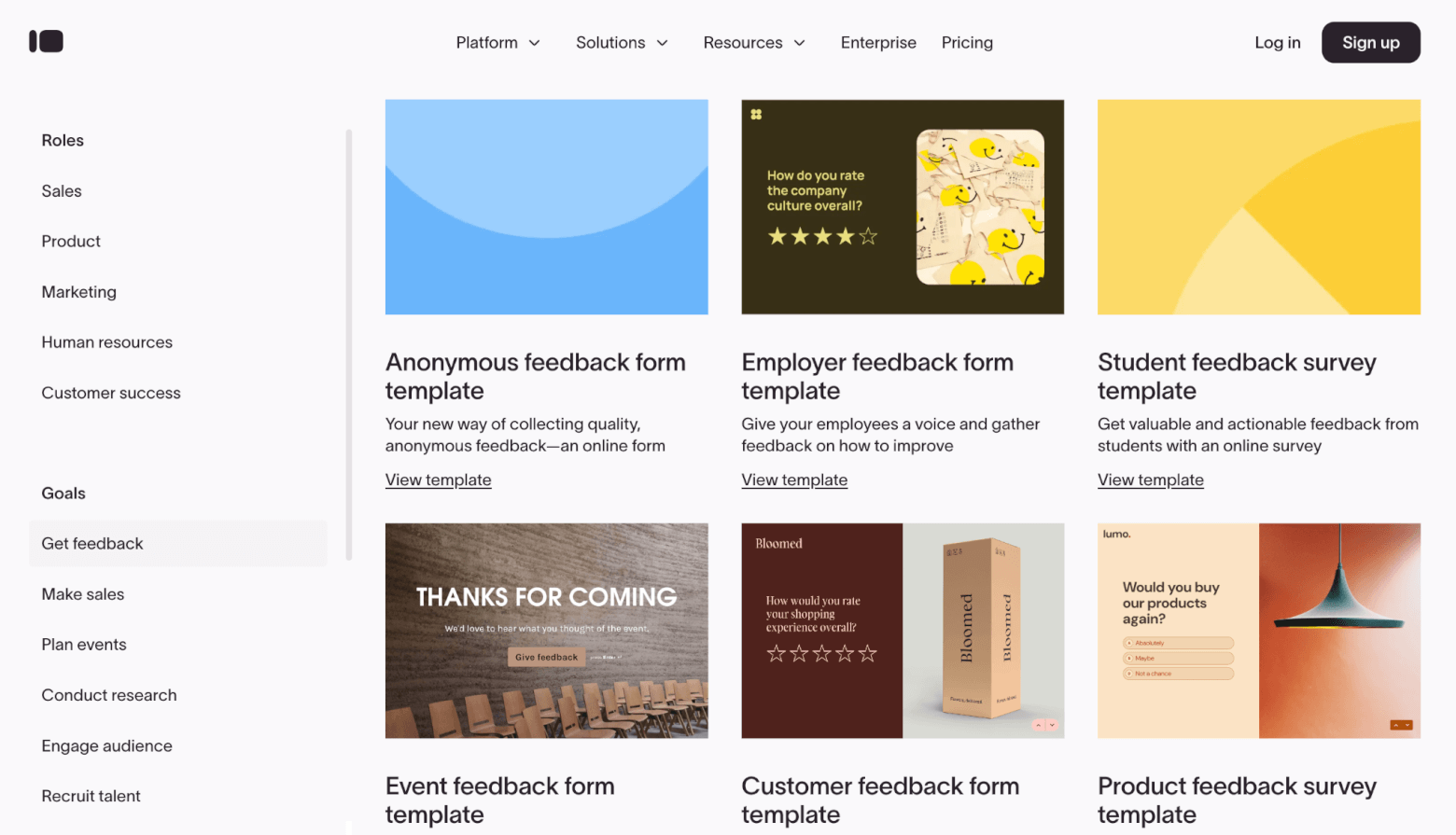
We all know how tedious filling out a survey can be, so imagine how enthusiastic customers must feel about it! That’s why we really like Typeform’s conversational approach. Instead of dumping a list of questions in front of users, it presents them one at a time. This makes feedback feel more like a chat than a form, and surprisingly, that small shift makes a big difference in completion rates.
Typeform’s free plan lets you create unlimited forms and surveys, with up to 10 responses per month. You can use its intuitive drag-and-drop builder to design feedback forms, NPS surveys, or post-purchase questionnaires in just a few minutes. It also includes ready-made templates for customer satisfaction, product feedback, and onboarding.
The design options are what set Typeform apart. Even on the free plan, your forms look polished and professional, with customizable colors, fonts, and background images. You can embed forms on your website or share them via a simple link, making it ideal for collecting customer feedback after a sale or service.
Pros:
- Beautiful, easy-to-build forms (that customers actually finish!)
- Free plan includes unlimited forms and templates
- Can integrate logic including branching, calculations, scores and variables
- Great for collecting customer satisfaction or product feedback
- Clean embeds for websites and emails
Cons:
- Limited to 10 responses per month on the free plan
- No file uploads, URL redirects, payment processing or premium themes without upgrading
- Can become expensive as response volume grows
Pricing: Typeform’s free plan includes unlimited forms, 10 monthly responses, and basic design customization. Paid plans start at $29/month, unlocking more responses and advanced features.
15. Systeme.io – For growing a community

If you’re ready to turn one-time customers into a loyal community, Systeme.io makes it easy to do exactly that. It’s an all-in-one platform that combines membership sites, email marketing, and automation tools all under one roof. It’s even possible to create an online course and run your own affiliate program out of the platform.
What’s really remarkable is how generous the free plan is. You can create up to 3 sales funnels, manage 2,000 contacts, send unlimited newsletters, and host your own membership site with 1 custom domain. That’s more than enough to launch and grow your first paid or free membership area.
You can organize your content into protected modules, drip lessons over time, or create private communities that keep customers engaged between purchases. For creators, coaches, or small businesses, it’s one of the easiest ways to add a recurring-revenue model without juggling multiple tools.
Pros (free plan):
- Create 1 community for free
- Supports memberships, funnels, and email marketing
- Manage up to 2,000 contacts, send unlimited newsletters, and access unlimited file storage
- Built-in CRM and automation tools
- Custom domain support even on the free plan
- 0% transaction fees, with support for Stripe, Paypal, Apple Pay and more
Cons (free plan):
- No way to customize the design of your community/membership pages
- Limited integrations compared to specialist tools
- Although you can send unlimited emails/newsletters, you can only send 1 email campaign per month
- Restricted to 1 automation
Pricing: Systeme.io’s free plan includes 3 funnels, 1 automation rule, 2,000 contacts, and 1 custom domain. Paid plans start at $17/month, unlocking higher limits.
16. Smile.io: For rewarding loyal customers
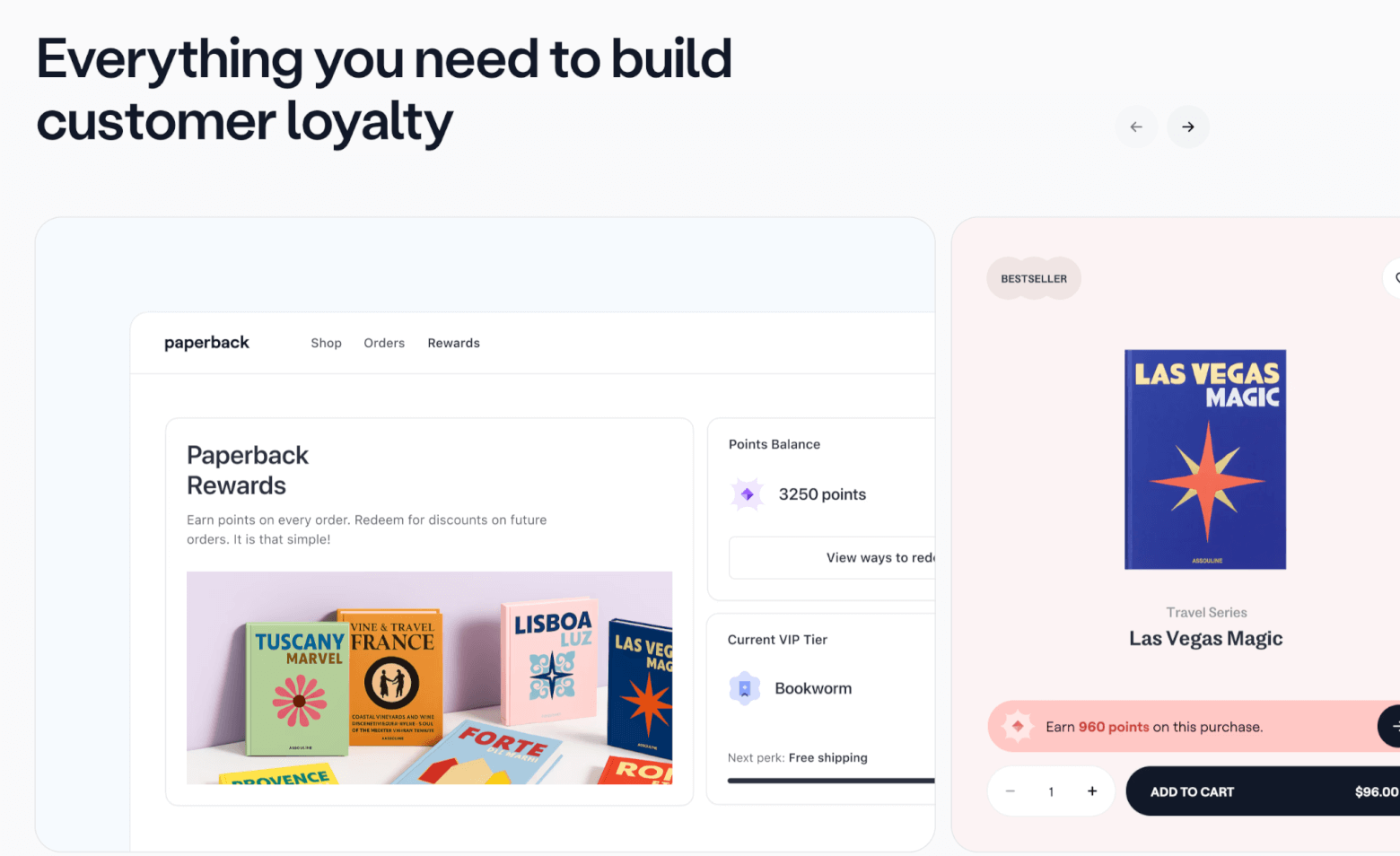
Building a customer loyalty program doesn’t have to be expensive or difficult. Smile.io makes it easy to launch your own loyalty and rewards program – yes, even for free! It’s designed for ecommerce businesses that want to reward repeat purchases, encourage referrals, and build lasting brand loyalty.
With Smile.io, you can create a simple points system (“Earn 100 points for every purchase”) or a referral program (“Give $5, get $5”), with a surprisingly generous free plan. This allows you to manage up to 200 orders per month and get access to features like points-based rewards, referral tracking, and basic analytics.
It also integrates directly with Shopify and BigCommerce, so you can add the rewards widget to your site and start collecting data right away. Setup is quick and beginner-friendly – a few clicks and you’re ready to reward customers for their actions.
Pros:
- Free plan includes points and referral programs
- Clean, beginner-friendly interface
- Can customize your program’s appearance to match your brand
- Available in 20 languages
- Encourages repeat purchases and organic referrals
Cons:
- Free plan limited to 200 orders per month
- Only supports Shopify and BigCommerce stores (they recently discontinued their Wix integration)
- No advanced customization or VIP tiers without upgrading
- Reward emails and branding are Smile.io-branded on the free plan
Pricing: The free plan covers up to 200 monthly orders and includes core points and referral features. Paid plans start at $49/month, adding advanced analytics, additional integrations, and VIP rewards.
17. Google Reviews: For building trust and social proof
When it comes to customer trust, few things carry more weight than what people say about you on Google. Google Reviews are one of the simplest and most powerful ways to build long-term credibility and loyalty.
Every review your business receives appears directly in Google Search and Google Maps, influencing potential customers at the exact moment they’re deciding whether to click, call, or visit.
By consistently asking satisfied customers to leave a review, you can improve your local SEO visibility, and strengthen your reputation. Positive reviews bring in new customers, while current ones feel more connected to your brand.
You don’t need a physical store to collect Google Reviews, either. Our company Tooltester delivers our services mostly online, but we also encourage our website users to leave us Google Reviews, which they are often happy to do:
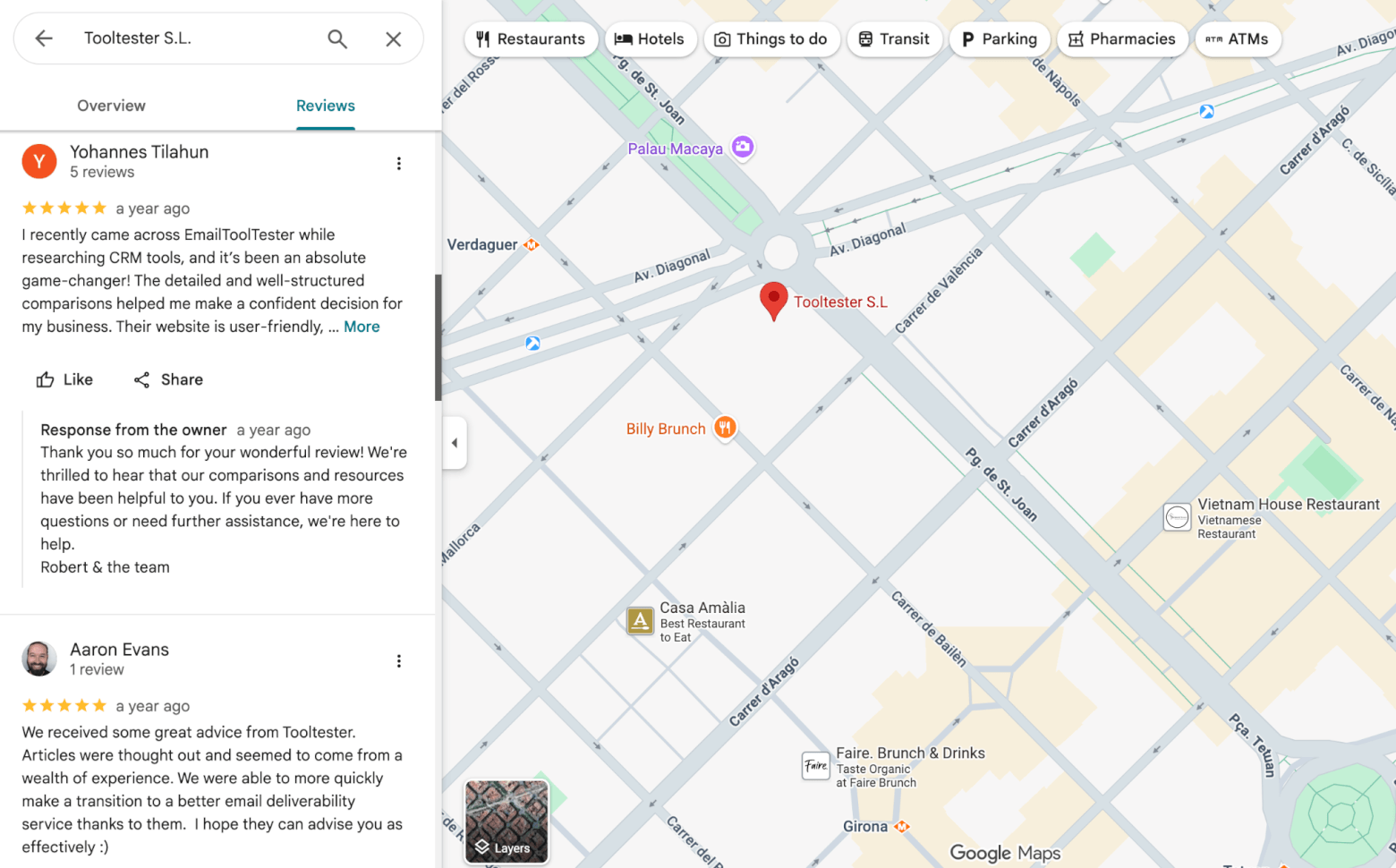
Pros:
- Completely free and easy to manage via Google Business Profile
- Boosts credibility and local search rankings
- Strengthens trust and customer relationships through public replies
- Encourages repeat business and referrals
Cons:
- Requires active management to handle negative or spam reviews
- No built-in automation for review requests (you’ll need to ask manually or via another tool)
- Limited analytics compared to dedicated reputation platforms
Pricing: Google Reviews are completely free as part of your Google Business Profile.
Stage 5: Growth — Optimizing and Scaling
So now, your marketing is up and running – emails are going out, customers are returning, and campaigns are generating results. But now comes the question every growing business faces: how do you keep scaling?
This is where smart automation and AI come in. The tools in this stage help you optimize your operations, eliminate manual busywork, and scale your marketing with less effort.
18. Zapier: For automating your marketing stack
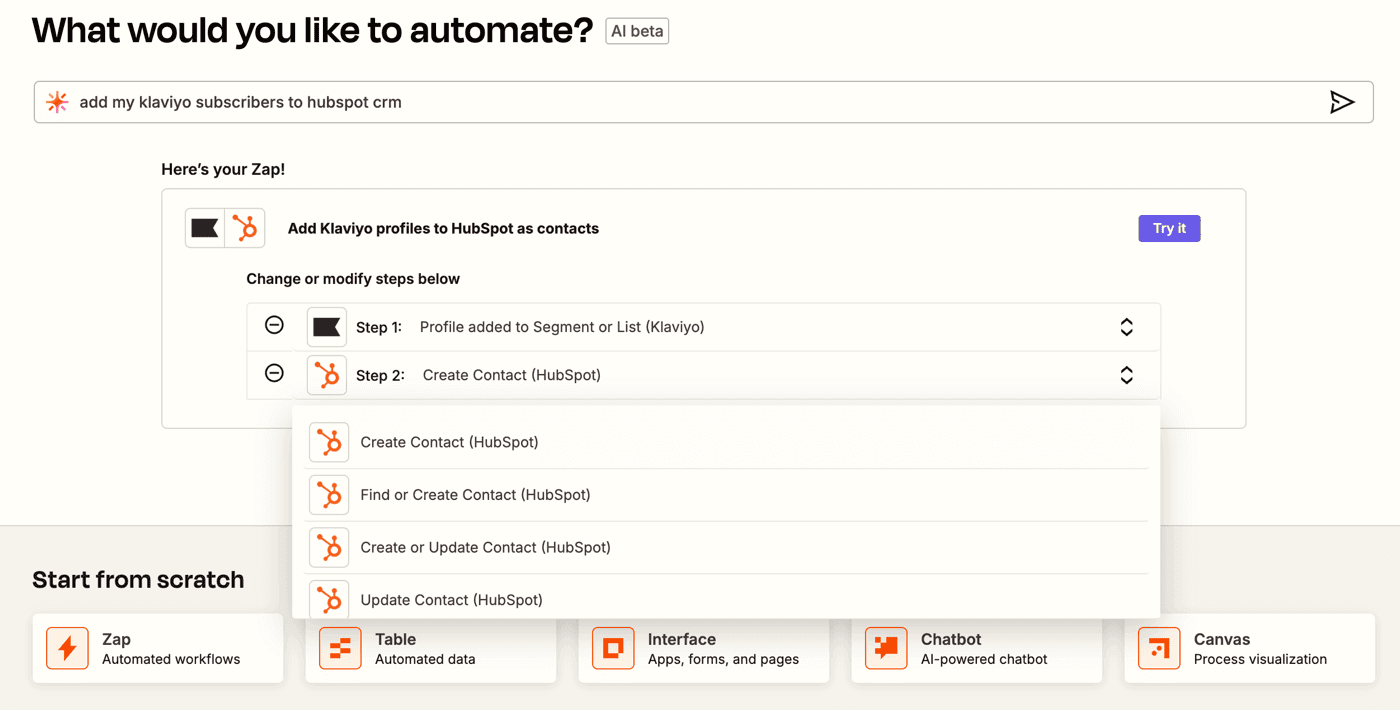
Every marketer has that one repetitive task they wish they could automate, and Zapier is often the answer. It connects over 8,000 apps (including CRMs, email platforms, and form builders) to create automations that save time and prevent human error.
The free plan includes 100 tasks per month and single-action automations (called “Zaps”). For example, you could automatically:
- Add new Brevo subscribers to your CRM
- Send a Slack message when someone books a Calendly meeting
- Save quiz responses from Involve.me to Google Sheets
It’s one of those tools that glues your entire marketing system together. Once you start using it, it’s hard to imagine working without it.
Here’s how my colleague Josep uses Zapier for automating his workflows:
Pros:
- 8,000+ integrations covering nearly every major marketing tool
- Easy to build automations; no coding required
- Great for connecting forms, CRMs, and analytics tools
- Reliable and stable even on the free plan
- Access to AI-powered Copilot to simplify workflow creation
Cons:
- Limited to 100 tasks/month with 2-step Zaps (trigger + action)
- Complex automations (e.g. conditional logic, multi-step workflows) require paid tiers
- Steep learning curve can make it tricky for first-time users
Pricing: The free plan includes 100 tasks/month and single-step Zaps. Paid plans start at $19.99, unlocking multi-step automations, premium apps, conditional form logic, and support.
19. Claude Desktop MCP: For AI-driven marketing automation
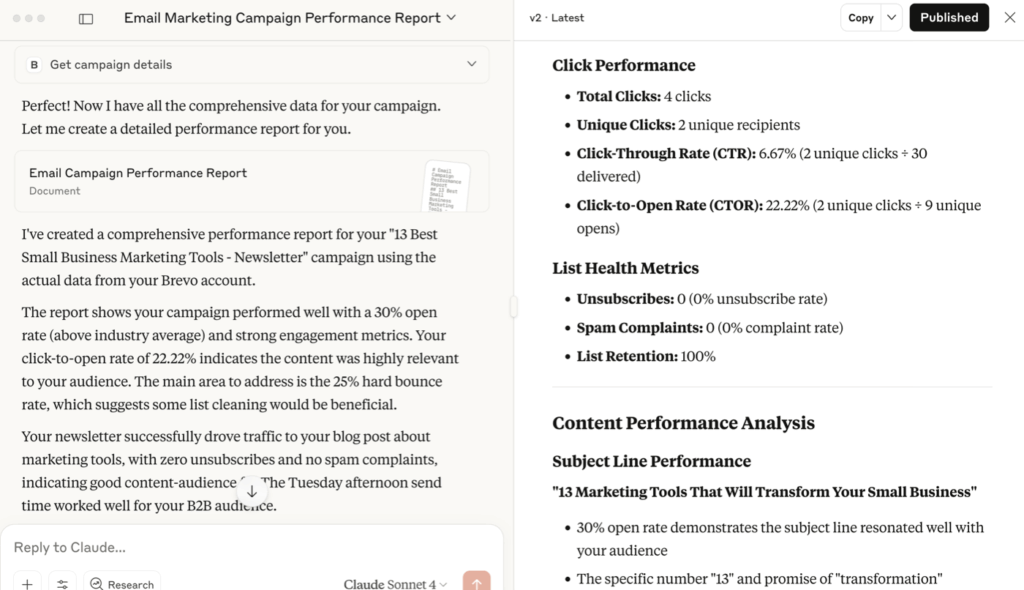
If you’ve ever wished you could just tell your computer what to do, this is as close as it gets. Some warning though: it does require a little bit of “geeking” out!
Claude, created by Anthropic, is the first app to fully embrace MCP (Model Context Protocol). MCP lets AI connect securely to your favorite tools and act on your behalf. While the free plan does limit which tools you’re able to connect to, we’ve been able to successfully connect Claude to Brevo by running the MCP locally through Claude’s desktop app.
As a result, we can now get Claude to automate marketing workflows that would normally take hours – all through simple text commands. For example, if we type: “Read and analyze <X> blog post, write a 200-word email summary, and create a draft campaign in Brevo”, Claude will coordinate those steps across multiple tools automatically.
For marketers, this means turning AI into a true assistant that executes, not just one that brainstorms. You can set up recurring automations like content scheduling or campaign reporting just by describing what you want in plain English. And because it runs locally on your desktop, it keeps your credentials and data secure.
It’s early days for MCP, but Anthropic is leading the way. If you’re curious about AI assistants that actually do the work for you, Claude Desktop is the place to start.
Pros:
- Free plan lets you create content, analyze data, and brainstorm ideas using AI
- Natively connects to tools like Notion, HubSpot, Figma, and Stripe
- With Zapier, links to 8,000+ apps for endless automation possibilities
- Executes multi-step workflows through natural-language commands
- Great for automating repetitive marketing tasks and content creation
Cons:
- Daily usage limits on the free plan are quite low
- Requires paid plans to integrate MCP with some tools (e.g. Notion, Airtable)
- Priority access and advanced features (larger context windows, additional models, “Projects” etc) are reserved for paid tiers
- Still an emerging technology — setup and experimentation required
- Limited to desktop for now (no mobile version yet)
- Some integrations may need initial Zapier configuration
Pricing: Claude’s desktop app is free to use, with additional capabilities depending on your Claude subscription plan. As we’ve seen, Zapier also offers a free tier (100 tasks/month) for basic automations.
20. Notion: For organizing marketing workflows

Few tools are as versatile for marketers as Notion. It’s part document editor, part project tracker, and part database, all wrapped in one clean, customizable workspace. Whether you’re managing an editorial calendar, planning a campaign launch, or storing client briefs, Notion makes it easy to keep everything organized and shareable.
The free plan is surprisingly generous. You get unlimited pages and blocks, real-time collaboration for up to 10 guests, and access to Notion AI, which can summarize meeting notes, brainstorm content ideas, or rewrite your copy in seconds. File uploads are limited to 5 MB, but that’s rarely an issue for most marketing projects.
For marketers juggling multiple campaigns or clients, this combination of structure and automation can help you execute your marketing more efficiently. In fact, our team uses Notion’s free account to document all our marketing processes, and it’s a huge timesaver to be able to go in and find everything in one place.
Pros:
- Free plan includes unlimited pages, blocks, and Notion AI access
- Ideal for planning campaigns, storing briefs, centralizing knowledge, and tracking performance
- Easy to search through content and find what you’re looking for
- Intuitive interface and great for small teams (up to 10 guests)
Cons:
- Unlimited pages/blocks only applies if you have 1 user
- File uploads limited to 5 MB on the free plan
- Team management, admin tools, and MCP integrations (e.g. with Claude) require a paid upgrade
Pricing: Notion’s free plan covers most individual and small-team use cases. Paid plans start at $12 per user/month, unlocking advanced collaboration, integrations, and unlimited file uploads.
Best Free Marketing Tools: Final Thoughts
We’ve tested hundreds of tools over the years at EmailTooltester – some brilliant, some less so. The ones we’ve included here are the ones we actually come back to, again and again. They save us time, spark ideas, and keep our workflows running smoothly.
If you’re not sure where to start, pick one stage and test a couple of tools that fit your current goals. Remember: the best stack is the one that actually gets used. And once you’ve found your rhythm, you’ll be amazed at how much you can achieve with a little creativity (and zero budget).
If you end up testing a few of these, I’d love to hear what you think. Drop us a comment and tell us which ones made your workflow smoother.
Our Methodology
This article has been written and researched following our EmailTooltester methodology.
Our Methodology
